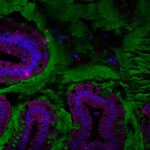Lien vers Pubmed [PMID] – 31393983
Lien DOI – 10.1093/ecco-jcc/jjz144
J Crohns Colitis 2020 Feb; 14(2): 216-229
Patients with Crohn’s disease [CD] harbour an increased number of adherent-invasive E. coli [AIEC]. The strain LF82, identified in the ileal mucosa of CD patients, has been extensively studied for pathogenic mechanisms. However, understanding of the interaction of LF82 with the intestinal mucosa of CD patients is lacking.Here, we investigated the importance of long polar fimbriae [LPF] type 1 pili and the carcinoembryonic antigen-related cell-adhesion molecule 6 [CEACAM6] for translocation of LF82 in an in vitro model of follicle-associated epithelium [FAE], and in the FAE and villus epithelium [VE] of patients with CD and controls, using Ussing chambers.Significantly greater LF82 passage occurred in the FAE model compared with in the VE Caco-2cl1 mono-culture. Moreover, bacterial translocation was inhibited by either LPF disruption or pre-incubation with anti-CEACAM6 antibody. Tissue mounted in Ussing chambers showed significantly higher LF82 passage in FAE from patients with CD compared with control FAE, that was diminished in LF82 lacking LPF and by blocking host CEACAM6. Interestingly, addition of LF82 to the CD FAE tissues significantly increased paracellular permeability [of 51Chromium-EDTA] compared with baseline, and the increase was inhibited by anti-CEACAM6. Immunofluorescence and immunoblots showed higher expression of CEACAM6 in FAE of patients with CD compared with in FAE from controls.These data suggest that the FAE of CD patients is a site of vulnerability for invasion by LF82 via a mechanism that requires both bacterial LPF and host CEACAM6. Further, LF82 has the ability to increase paracellular passage through the FAE of patients with CD. These data can help define novel therapeutic targets in CD for the prevention of clinical recurrence.


